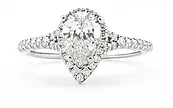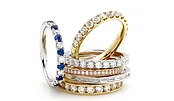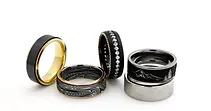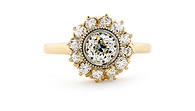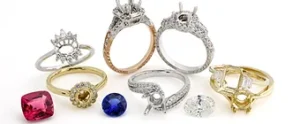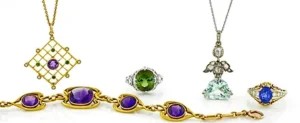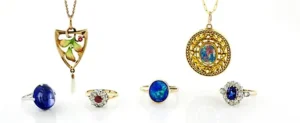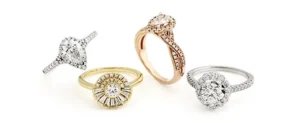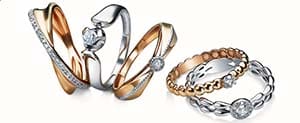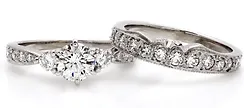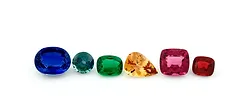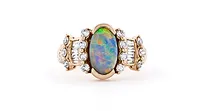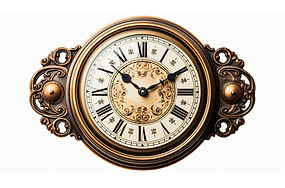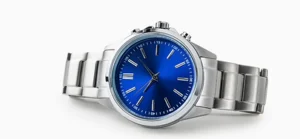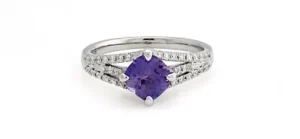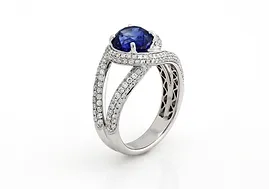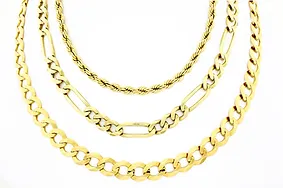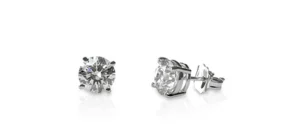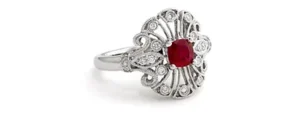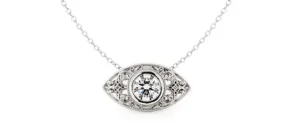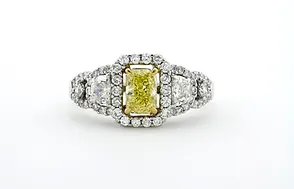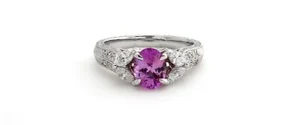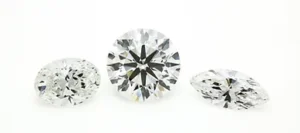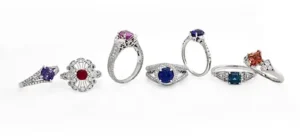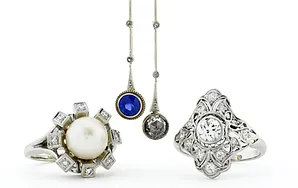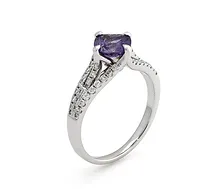Vintage Jewelry Boxes have been used since antiquity but were generally owned by people of the upper crust and nobility that could afford the more expensive jewelry which warranted the use of a jewelry box. As with many antiques, the pride in workmanship shown to even the small details was amazing, and has left us with relics of the time. Jewelry boxes tend to fall into two types: larger jewelry boxes, jewelry armoires, and chests which are used to house multiple items or safely store a collection of jewels; and smaller jewelry boxes, like individual ring boxes, necklace cases, earring boxes, and other presentation boxes used to store a single item or used to present an item to a new owner.

Collection of Georgian and Victorian jewelry boxes.
In the Georgian Era, jewelry boxes were totally hand made, often to fit the individual piece, and thus they are very rare and expensive today. With the proliferation of jewelry during Victorian times – mainly the second half of the 19th century- there was an increased demand for jewelry boxes. The industrial revolution increased availability of materials and mass production of boxes began in earnest, though they were still assembled by hand. Any antique ring box made prior to 1920 would have been made from wood and leather, hand assembled with brass tacks and felt, and modified to fit the particular item it was to house. The finest boxes would have been made in gold or silver and set with additional gems as a hint of what was to be kept inside. While the finest boxes included a diverse array of styles and designs, most antique jewelry boxes of the 19th century are similar in design and appearance, and are quite collectible today.
By the turn of the 20th century, more jewelry was being sold- including the now ubiquitous engagement ring- so Jewelry Boxes were becoming more common even for more affordable jewels. Improvement of mass production techniques allowed manufacturers to complete boxes faster, and later developments of early plastics and stainless steel fittings allowed them to be made more quickly and more durably. Some of the best antique ring boxes are Art Deco, crafted in celluloid in wild Art Deco colors with groovy designs straight from the roaring 20’s. While these boxes had become more affordable and common, they were still a jeweler’s expression of style and an important part of the purchase.

Mid century bi-fold jewelry box with drawers and mirror, circa 1955.
Fine jewelry was not the only thing to be in reach to the new middle class in the middle of the 20th century: for the first time, manufacturing techniques had advanced enough to make the production of costume jewelry affordable for the masses. In 1850, only the wealthy would have owned a jewelry box, and it would have had a few select items (wedding band, brooch, locket, pocket watch, more if they were lucky). But by 1950, every woman had a jewelry box. There may have only been a few pieces of fine jewelry (wedding ring, maybe a right hand anniversary ring and a few heirloom pieces) but most women would have assembled a jewelry wardrobe of costume pieces for every occasion, and they needed a place to store them. Elaborate jewel boxes and jewelry armoires have been popular ever since, giving wearers the ability to display and safely store their collections.
Federal Way Custom Jewelers does not sell or display large jewelry boxes, but we have a great collection of antique ring boxes and other antique jewel cases that we use to display items in our Antique & Estate cases. It is one of our greatest joys to see a case full of antiques – displays and jewelry alike. If we find a ring in its original box, we keep them together, though this is a rare occurrence. In most cases we source a ring, pendant or earring box of similar vintage and from a similar source as to be correct for the item being sold. These boxes are displays, and do not come with the rings when purchased (they are available for purchase in some instances, just speak with us at time of sale).
We are always interested in buying antique jewelry boxes! While we are always buying antique jewelry, it can be even harder to find the authentic jewelry boxes, and we will pay fair prices for examples in good condition. Do you have an antique ring box? If so, bring them in! We hope you enjoyed reading about Vintage and Antique Jewelry Boxes. This would be a good time to visit our on-line store and check out our selection of vintage jewelry there.
Return to Engagement Ring Menu
Frequently Asked Questions
What should I look for in an antique jewelry box?
When choosing an antique jewelry box, look for quality craftsmanship, durable materials like wood or metal, and original details such as inlays, intricate carvings, or vintage hardware. Original lining and compartments are also valuable features.
What makes a good antique jewelry box?
A good antique jewelry box combines beauty and functionality, offering compartments to protect individual pieces. Authenticity and preservation of original features like clasps, hinges, and interior lining add to its value and appeal.
How do I know if my antique jewelry is valuable?
To assess the value of antique jewelry, examine materials, craftsmanship, and any maker’s marks or hallmarks. Research its historical period and consider having it appraised by a professional to determine its rarity and market value.
How to pick an antique jewelry box?
When picking an antique jewelry box, consider the type of jewelry you’ll store, the box’s condition, and its design style. Select one that complements your decor and has well-preserved interiors to safely store and showcase your pieces.

